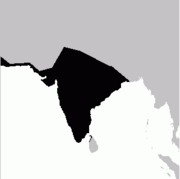Ortygornis

| Ortygornis | |
|---|---|
 | |
| O. pondicerianus | |
| Scientific classification | |
| Domain: | Eukaryota |
| Kingdom: | Animalia |
| Phylum: | Chordata |
| Class: | Aves |
| Order: | Galliformes |
| Family: | Phasianidae |
| Tribe: | Gallini |
| Genus: | Ortygornis Reichenbach, 1852 |
| Type species | |
| Tetrao pondicerianus (grey francolin) Gmelin, SF, 1789 | |
| Species | |
| Ortygornis sephaena | |
| Synonyms | |
| Dendroperdix (Smith, 1836) | |
Ortygornis is a genus of birds in the francolin group of the family Phasianidae.
Taxonomy
[edit]The genus Ortygornis was introduced in 1852 by the German naturalist Ludwig Kaiser to accommodate a single species, the grey francolin, which is therefore the type species.[1] The name combines the Ancient Greek ortux meaning "quail" with ornis meaning "bird".[2]
The genus now contains three species, one found in Sub-Saharan Africa and two found South Asia (with one also being found in Iran). The species are:[3]
| Common name | Scientific name and subspecies | Range | Size and ecology | IUCN status and estimated population |
|---|---|---|---|---|
| Crested francolin | Ortygornis sephaena (Smith, 1836) Five subspecies
| southern Africa. | Size: Habitat: Diet: | LC
|
| Grey francolin | Ortygornis pondicerianus (Gmelin, JF, 1789) Three subspecies
| India and Iran. | Size: Habitat: Diet: | LC
|
| Swamp francolin | Ortygornis gularis (Temminck, 1815) | the Himalayas in northern India and Nepal. | Size: Habitat: Diet: | VU
|
Of the three species, the crested francolin was formerly placed in its own monotypic genus, Dendroperdix, while the two Asian species were formerly placed in Francolinus. Phylogenetic analyses support these three species grouping together as a distinct clade.[5][6]
References
[edit]- ^ Reichenbach, Ludwig (1852). Handbuch der speciellen Ornithologie (in German). Vol. 1. Dresden und Leipzig: Expedition Vollständigsten Naturgeschichte. p. xxviii. For a discussion of the publication date see: Dickinson, E.C.; Overstreet, L.K.; Dowsett, R.J.; Bruce, M.D. (2011). Priority! The Dating of Scientific Names in Ornithology: a Directory to the literature and its reviewers. Northampton, UK: Aves Press. p. 134. ISBN 978-0-9568611-1-5.
- ^ Jobling, James A. (2010). The Helm Dictionary of Scientific Bird Names. London: Christopher Helm. p. 285. ISBN 978-1-4081-2501-4.
- ^ Gill, Frank; Donsker, David; Rasmussen, Pamela, eds. (January 2022). "Pheasants, partridges, francolins". IOC World Bird List Version 12.1. International Ornithologists' Union. Retrieved 6 July 2022.
- ^ N. Sarudny und M. Härms, Ornithologische Monatsberichte (1913) - Neue Formen der Frankoline aus Persien
- ^ Mandiwana-Neudani, T.G.; Little, R.M.; Crowe, T.M.; Bowie, R.C. (2019). "Taxonomy, phylogeny and biogeography of African spurfowls Galliformes, Phasianidae, Phasianinae, Coturnicini: Pternistis spp" (PDF). Ostrich. 90 (2): 145–172. Bibcode:2019Ostri..90..145M. doi:10.2989/00306525.2019.1584925. S2CID 195417777.
- ^ Kimball, R.T.; Hosner, P.A.; Braun, E.L. (2021). "A phylogenomic supermatrix of Galliformes (Landfowl) reveals biased branch lengths". Molecular Phylogenetics and Evolution. 158: 107091. Bibcode:2021MolPE.15807091K. doi:10.1016/j.ympev.2021.107091. PMID 33545275. S2CID 231963063.






